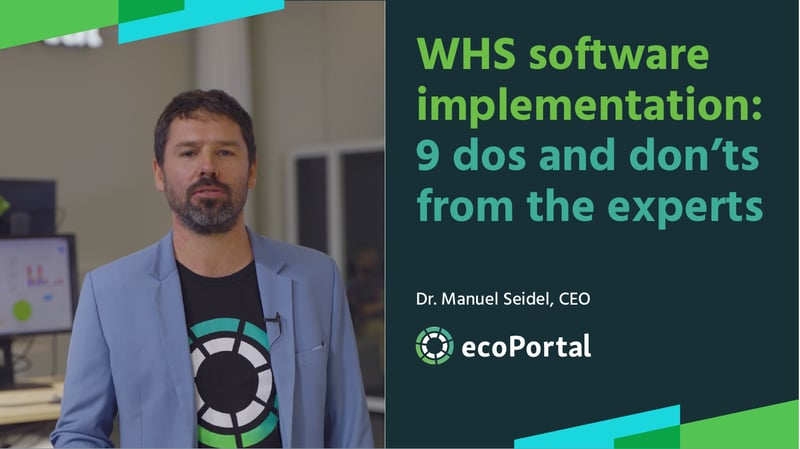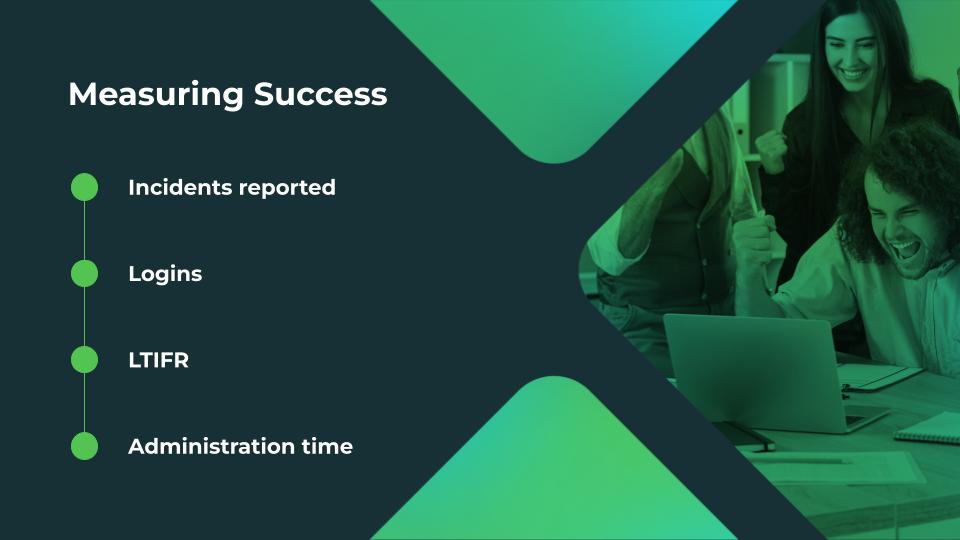
Technology can help fast-track a transformation in the way your organisation does and sees safety for the better, leading to:
- Less time lost to administration work
- A higher rate of incident reporting before incidents become accidents
- An increase in engagement with your safety goals at all levels
The reality of that means that more of your people are going home unharmed to their families every day.
But not all technologies are built equal. Sometimes, an old technology no longer matches your goals and it’s time to level up.
WHS leaders are often at the head of the charge in implementing new safety software. It’s a big undertaking. You’re investing not only the cost of the software but the time taken to implement. And implementation projects fail. All. The. Time.
Standish Group reports that only 31% of implementation projects are successful, and of that 31%, only 46% return high value on investment. Those are tough odds.
Why do so many of these implementations fail? There are many roadblocks at various stages.
The main challenges of WHS software transformation come about not only when navigating vendor selection to find the technology partner right for you, but configuring and rolling out that software throughout the organisation using best-practice change management so that users at all levels feel engaged, and so positive change can come about.
I’ve been in the business of safety for a while now. I’ve worked over the last 15 years alongside hundreds of organisations to implement safety software, and I collaborate every day with a stellar team of Safety Leaders and Project Managers at ecoPortal now.
Here are 9 tips gleaned over my and my expert team’s years of experience successfully digitising WHS programmes for a range of organisations, especially at the enterprise level. These points have been collated in collaboration with ecoPortal’s Project Management team—the group of experts working directly with our customers to beat the odds.
Do: Build your A-team
In the middle of the selection and implementation whirlwind, you need a key decision-maker standing strong—a change manager, a champion.
This individual should be leading the journey from the beginning, and be focused on the ‘why’ and the ‘what’s coming’ rather than the ‘how to’ of your implementation journey.
However, you can’t have only this person. Having just one individual participating in the entire process is a business risk, especially if documentation is lacking. So establish health & safety champions throughout your business. These individuals can contribute to the planning and implementation process, and take ownership of this new software alongside you.
Pulling in people with different viewpoints will strengthen the system’s ability to meet all users’ needs, as well as the needs of the business. Such individuals also help drive adoption and engagement further across the organisation.
A system owned by everyone is more efficient and longer-lasting, with a much clearer path to succession and success. So gather this range of representatives, allocate resources, design roles, and clearly lay out your objectives.

A SYSTEM OWNED BY EVERYONE IS MORE EFFICIENT AND LONGER-LASTING, WITH A MUCH CLEARER PATH TO SUCCESSION AND SUCCESS.
Without a common understanding of roles and responsibilities, things can fall apart quickly, leading to delays, reworking, and broken timelines. By the time implementation begins, you should already have your team ready and be clear on each individual’s part.
.jpg?width=800&height=450&name=Blog%20slides%20(5).jpg)
No software implementation A-team is complete without a strong vendor partner. Choose a vendor partner that puts an expert right beside you, who has been through it all 100 times before. Stand on their shoulders and avoid the common pitfalls. A dedicated onboarding and success team will guide you through the process as you build your safety future.
Don’t: Leave your stakeholders behind
Creating meaningful, effective change at any level becomes near-impossible if your A-team isn’t on the same page with your stakeholders, so you need to engage your stakeholders first.
When leadership sets clear expectations, models strong safety, and pairs its programme with an easy-to-use software that reflects the organisation’s goals, active participation can improve across all levels of the organisation.
It takes a lot, but this buy-in can be the difference between being on track to build an excellent platform that matches your needs, and running way late in building something that doesn’t quite make sense.
So the absolute first thing you need to do, before starting any kind of discovery—far before implementation—is solidify your vision, goals, and needs, and get your stakeholders on the same page and engaged.
This means involving different stakeholders in the requirements scoping, building a strong business case, and taking the time to understand the current barriers to engagement.
Stakeholder groups worth engaging include:
- The senior executive committee
- EHS directors
- EHS managers
- IT program managers
- Field workers responsible for reporting on EHS metrics
Do you have the ability to sell your vision and change minds? If you’re not the storytelling type, who else on your team can be the champion to influence executives and stakeholders?
Don’t: Neglect the relationship between your core objective and your solution
Are you looking to achieve compliance—tick the boxes and go home? Are you looking to build a stronger safety culture throughout the organisation? Everyone should be clear on the objective before selecting a software solution.
If your objective is to achieve engagement, to really embed a safety culture in your organisation, then you must bring your people along with you for the ride. Avoid vendors that charge per user if this is your goal—such frameworks often mean frontline staff access gets cut, lowering costs but eliminating widespread engagement.

IF YOUR OBJECTIVE IS TO ACHIEVE ENGAGEMENT, TO REALLY EMBED A SAFETY CULTURE IN YOUR ORGANISATION, THEN YOU MUST BRING YOUR PEOPLE ALONG WITH YOU.
Regulatory change can be hard to predict. To go beyond compliance requires more ground work, but when you adopt safety as a cultural shift, you become more agile and adaptable to sudden changes. You’ll stride ahead of tomorrow’s compliance requirements before they even appear, saving you energy in the long run.
A good vendor partner will support you to achieve compliance now, through features such as real-time data analysis and digital incident documentation, while also having the vision to create a cultural shift that preempts later needs.
Do: Map your present and future
During implementation, you should have a clear outline of your existing processes ready to go—your workflows, your hierarchies. Who can report an incident? Who manages the incident? Don’t make things up on the fly.
If you’ve already spent time carefully crafting safety procedures and processes that work for your organisation and engage your people, then you want to be able to configure those workflows to exist similarly in the new digital environment. This will also ease the transition to the new system.
If you’re looking for a full system overhaul, spend time in advance making a clear map of your ideal future—your dream state. Outline what would go and what would stay to get from one to the other. But always make room for guidance from the experts around you.
It doesn’t have to be a complete revision, and it shouldn’t be rigid, but it should be a sketch that gives a framework to the conversations about the past and the potential future, helping ensure a smooth transition to any required change.
Do: Build hype
There’s no point in getting a system up and running if nobody knows about it. Before you roll out your chosen solution, it is integral that you have an intimate understanding of what the new software is and why it’s being implemented—its value—and that you communicate that value across your organisation.
.jpg?width=960&height=540&name=Blog%20slides%20(4).jpg)
Be innovative in your communications. No one will read an email or look at a poorly designed poster, so what does engage?
A great way to kickstart the process is with an internal poll to name the new system. Once that’s decided, it’s time to brand the system and build anticipation. Set up well-designed posters at key congregation areas, send out alerts that a new safety portal is coming.
Small things like phrasing can make a platform really feel like home. One seafood company I’ve worked with calls their near misses ‘A Great Catch’ in their system. A forestry client we work with calls their platform The SHED, while a fishing client calls their platform The Tacklebox.
You should have a communications and training plan that carries you from six weeks through to the platform going live. That plan should include action items that contribute to…
- Creating awareness (as part of this, one organisation that we’ve worked with installed a countdown timer widget on their SharePoint)
- Driving technical capability
- Figuring out who needs what training
- Instating check-in sessions
Don’t: Recreate the wheel
An important consideration in the software selection process is the pros and cons of a highly configurable solution—blank piece of paper, sky’s the limit—versus one that you can pull right out of the box and get to work in.
One of the really exciting things about modern health & safety software is that you can configure it to suit your needs, but this is also where a lot of people get bogged down.
A blank piece of paper can be enticing, but there are drawbacks:
- Building from scratch will take a lot more hours, energy, and training to reach usability and start to add value.
- Starting from zero means that you’re floating adrift from the tried and true. During UAT you’ll notice that out-of-the-box items from a trusted software make for more efficient implementation because they have already been thoroughly tested.
- A very bespoke product is harder to change in the future.
- An overly bespoke system runs the risk of a new safety manager coming in, teams changing over, everything being thrown out, and having to start from scratch again.
Less bespoke is more efficient, sustainable, and flexible long-term. But there are drawbacks there too, as you have unique needs to which you want your system to be able to respond. Large companies and enterprises especially need to choose a software that is adaptable to their unique needs, but is also fairly clean out of the gate.
.jpg?width=960&height=540&name=Blog%20slides%20(3).jpg)
‘Too bespoke’ means building something completely from scratch (rather than making updates to the template) and workflows that include so much detail that any change runs the risk of breaking the system (for example, different incident reports that offer too many sub-categories).
Configurability needs will vary, depending on your business’ risk profile, organisational structure, language, industry, and how much you want to retain of your existing health & safety framework. Ask yourself of each aspect of configuration, what’s the value?
To bespoke or not to bespoke? That is the question! My top tips are:
- Don’t recreate the wheel. Stand on the shoulders of others in your industry through the support of your vendor partner.
- Use the 80/20 rule. Rather than trying to build the perfect solution up front, make space for more feedback from the user group and adjust the last 20% as you go. Get something running, and live with it before deciding what you really need to fine-tune.
- Choose where to put your focus. Decide on what modules are sufficient as-is, and what modules you’d like to devote more time to getting down to the details. For example, in my and my Project Managers’ experience, you can afford to take a more standard approach to incidents and hazards, but for the likes of audits and inspections there are more nuanced regulations and compliance checks needed depending on the industry and risk profile of the organisation.
- Lather, rinse, and repeat these lessons in regards to integration with existing systems. There are some great integrations out there—payroll integrations for example streamline your people data and save you a great deal of time in the long run. Another popular integration is Single Sign-On, which not only streamlines user access but significantly improves security over the use of an additional username and password. Stop and assess the benefit of each potential integration.
Do: Choose your vendor wisely
Processes can be tweaked rather than overhauled when you’re beginning from somewhere close to your needs already. It pays to select your software with this in mind, stick closely to OOtB as much as possible, and focus your configuration energy on making the system engaging.
When it looks and feels like a part of your business—in language, in name, in colour scheme—users are more likely to feel like they own the system and are not only prepared but excited to engage in it.
In one of our banking customers’ SharePoint intranet portals they have a link to 'report something' and by clicking this the user is seamlessly taken to their health & safety platform. The platform has a bespoke name and its branding matches their SharePoint exactly, so that it looks and feels like a native software system. All this takes is SSO capability and an ability to configure the name and visuals of the platform.

WHEN THE SYSTEM LOOKS AND FEELS LIKE A PART OF YOUR BUSINESS, USERS ARE MORE LIKELY TO FEEL LIKE THEY ARE NOT ONLY PREPARED BY EXCITED TO ENGAGE WITH IT.
Pay close attention to your potential vendor partner’s software’s capabilities and limits.
- If you are a large enterprise with sub-businesses that have different branding, can your potential vendor partner customise each platform to look and feel like part of that business?
- Are the existing templates intuitive and simple-to-use?
- How many scenarios are already accounted for in the OOtB software?
Do your due diligence, scoping out exactly what is going to come OOtB, what might need to be configured differently, and what will not be possible. If there’s something you know your team cannot live without in their safety software, be clear on it, and check if your prospective vendor partner can get it done, either bespoke or—even better—as part of their OOtB product.
Do: Find a partner you trust, and trust them
After doing all the work of navigating vendor selection, and having deemed your selected software a worthy partner, if they’ve designed something that works really well, how much do you really need to change?
As I have mentioned, it’s wise to lean on the vendor’s vast experience. A good vendor partner should be able to advise you on what’s best in your area, what others in your industry are doing and how you can in turn improve your existing workflows. You should take advantage of what your vendor has learnt from their years of implementation.
The health & safety landscape is changing all the time. You want a vendor partner that will stand by your side across years of your safety journey, making those small continuous tweaks as well as helping you keep one step ahead of regulatory changes, trends, and technological advancements.

YOU WANT A VENDOR PARTNER THAT WILL STAND BY YOUR SIDE ACROSS YEARS OF YOUR SAFETY JOURNEY.
How does your potential vendor partner respond to sudden shifts in the health & safety landscape? Take COVID-19, for example. The global outbreak brought unprecedented challenges to businesses at all levels—how did your potential vendor partner handle it?
Some softwares took their sweet time implementing responsive templates for managing the new COVID-19 protocols—months or even longer. Here at ecoPortal, within only 48 hours of the official COVID-19 response notification, we designed, tested, and released a comprehensive set of workflows that supported our clients to navigate all of the pandemic’s complexities, including:
- Facilitating efficient and accurate Rapid Antigen Testing procedures.
- Developing a comprehensive leader onsite checklist.
- Supporting organisations to report and manage potential COVID-19 cases at the workplace with suspected case notifications.
- Offering a streamlined form for feedback on COVID-19 safety measures from various branches within an organisation.
- Building a workflow for maintaining and tracking an accurate-at-all-times record of members’ COVID-19 status.
- Creating a health check-in solution for organisations to track their employees’ health and to report symptoms.
Releasing a contact tracing workflow for potential exposures to the virus. - Managing the administration and tracking of vaccine doses as they became available.
We deployed these workflows to clients within 12 hours of their requests—a remarkable turnaround time that allowed our clients to promptly implement these critical tools, greatly empowering them in their navigation of the pandemic’s challenging circumstances.
WHS software should be a long-term investment that considers both your present and your future requirements over at least the next five years. Ask:
- Will you be offered ongoing support to reach and re-reach your ideal state?
- Will you have a customer success manager?
- How often does your potential vendor partner release new features and updates?
- What do existing clients say?
Don’t: Skimp on User Acceptance Testing (UAT)
One of the biggest barriers to successful implementation is engaging your frontline workers. What seems to be the dream system to the core implementation team can turn out to be everyone else’s nightmare.
If you don't conduct sufficient user acceptance testing before rolling the system out to the wider organisation, you run the risk of making a poor first impression. The engagement ship has sailed and you'll have to work 10 times as hard to get people to participate again.
You want the system to be engaging. Look for vendors with in-built features that make it easy for people to actively participate. The system should be...
- Accessible
- Mobile-capable
- Integrated with your other systems
- Able to incorporate multimedia content
- Convenient in the little features, such as voice-to-text inputs
- Intuitive and clean-looking
- Streamlined so you only see what you need to
UAT is one of the most important parts of the implementation process because it makes sure that these aspects of the platform that make it engaging and accessible are actually doing just that.
%20cropped.jpg?width=800&height=409&name=Blog%20slides%20(2)%20cropped.jpg)
You have a core project team, who will make most of the decisions based on their conversations, experience, knowledge, and assumptions of how the system should work, but there needs to be a point—two to three weeks—where these theories are tested out before they’re unleashed on hundreds.
Health & safety managers shouldn’t be making the tool that’s best for only them, or only senior executives, but a tool that works for everyone. The project team can be very health & safety-focused—very technical. They spend a lot of time with legislation and policy requirements, and that doesn’t always translate well to simple, usable, repeatable technology.

HEALTH & SAFETY MANAGERS SHOULDN'T BE MAKING THE TOOL THAT'S BEST FOR ONLY THEM, BUT A TOOL THAT WORKS FOR EVERYONE.
They might use the phrase ‘critical risk’. What does this language mean to the lay user? How effective is it? You’ll find out a lot very quickly when you test how someone with no training handles the system in a given scenario.
Good UAT leads to a better and more accessible user experience, which in turn leads to higher adoption and engagement rates, bridging the gap between the human and the system, and between the administrator and the frontline worker.
.jpg?width=960&height=540&name=Blog%20slides%20(1).jpg)
Just as much as I’m in the business of safety software, I’m in the business of engagement. If your goal is to really embed a culture of safety within your organisation, or even if your goal is just compliance, it’s so, so important to bring your people to the system. If they’re in the system and have a poor experience or see it as time-consuming or opaque, then they’re unlikely to report near misses and hazards going forward.
A client that compromises on allowing enough UAT time loses down the track, finding things they need to make changes to even as they’ve moved on to final site launch preparations. Don’t skimp on the number of people doing the UAT either. More people and more time testing means fewer problems down the road.
Final words: measuring success
So you’ve completed your WHS software implementation and want to reflect on the process. How do you measure your success?
Success will look different to different organisations. Across the board, though, success can only begin to be accurately measured at least six months after implementation.
It’s important to get implementation right because those first six months can be wonderful or terrible. If they’re terrible, it might be an even longer time before either the selected software is brought to standard or is replaced by another. Both of those options are costly and stressful.
Select a software that automatically calculates key success metrics in real-time, and factors in a range of leading and lagging indicators. Metrics could include:
- Incidents reported (proactive vs reactive)
- People logging in
- Lost Time Injury Frequency Rate (LTIFR)
- Administration time

Our Project Managers work with customers to achieve real results in their desired metrics by following the above dos and do-nots as guiding principles:
- One client has a 600% increase in reports with a large improvement in proactive reporting.
- A government client saw a 125% increase in incidents reported after 1 year and 190% increase after SSO was implemented on top.
- Another government client saw a 200% increase in near-miss reports, which also, unsurprisingly, led to a reduction in serious incidents and near misses.
- A tourism client of ours cut their LTIFR by two thirds in the first 18 months.
The numbers don’t lie. We gear up and partner with customers for success.
WHS software implementation is a big undertaking. But with these tips, and the right tools and vendor partner at your side, effective software has the potential to transform the way your organisation manages safety, leading to massive change for the better throughout your organisation.







